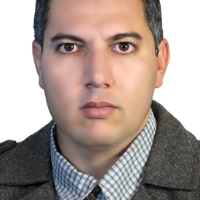Modeling of soil erodibility in the Khoor and Biabanak region, using remote sensing indices
Author(s):
Abstract:
Soil erosion by water and wind processes are carried out widely. So one of the best ways to estimate soil loss and land degradation is regional erodibility model. The aim of this research is codification regional erodibility model by statistical methods, the relation survey in Khoor and Biabanak between physical properties of soils and remote sensing indices. Sampling Method field was linear transect method and picked up 33 soil samples from depths of 0 to 50 cm. By transferring the samples to the laboratory, were calculated the elements of sand, clay, silt, organic matter and carbon, and then measurement erodibility values using the K-factor and SEI index. Then, was taken OLI sensor image accordance time sampling from USGS website. And were extracted the indices by enforcing functions the amount of Clay, NDVI, GOSAVI, SAVI, TSAVI, NDSI, SCI and GSAVI. Finally, were calculated using Pearson correlation between physical elements and soil erodibility with Remote sensing indices. At the end of for modeling SEI and K, through simple and multiple regression attempts to gauge the relationship between these parameters and selected best models from among with higher preference value. The results of modeling SEI represents the maximum linear correlation with the indices SAVI, NDVI and TSAVI respectively, with coefficient of 0.69, 0.66 and 0.63, and K factor linear correlation with the indices NDSI, SAVI and SCI, respectively, with a coefficient of determination 0.63 0.61 and 0.58 is at level 99%. Multiple regression analysis also showed a high correlation with group consensus SEI, K and Remote Sensing indices, respectively, with a coefficient of determination 0.517 and 0.564 and estimated error 0.0031144 and 0.0092369 at level 99%. Therefore, can estimate the amount of soil erodibility by remote sensing indices and univariate and multivariate statistical models. Which enables fast and precise estimation of SEI and K values in the Khoor and Biabanak region.
Keywords:
Language:
Persian
Published:
Desert Ecosystem Engineering Journal, Volume:5 Issue: 13, 2017
Pages:
67 to 80
magiran.com/p1668374
دانلود و مطالعه متن این مقاله با یکی از روشهای زیر امکان پذیر است:
اشتراک شخصی
با عضویت و پرداخت آنلاین حق اشتراک یکساله به مبلغ 1,390,000ريال میتوانید 70 عنوان مطلب دانلود کنید!
اشتراک سازمانی
به کتابخانه دانشگاه یا محل کار خود پیشنهاد کنید تا اشتراک سازمانی این پایگاه را برای دسترسی نامحدود همه کاربران به متن مطالب تهیه نمایند!
توجه!
- حق عضویت دریافتی صرف حمایت از نشریات عضو و نگهداری، تکمیل و توسعه مگیران میشود.
- پرداخت حق اشتراک و دانلود مقالات اجازه بازنشر آن در سایر رسانههای چاپی و دیجیتال را به کاربر نمیدهد.
دسترسی سراسری کاربران دانشگاه پیام نور!
اعضای هیئت علمی و دانشجویان دانشگاه پیام نور در سراسر کشور، در صورت ثبت نام با ایمیل دانشگاهی، تا پایان فروردین ماه 1403 به مقالات سایت دسترسی خواهند داشت!
In order to view content subscription is required
Personal subscription
Subscribe magiran.com for 70 € euros via PayPal and download 70 articles during a year.
Organization subscription
Please contact us to subscribe your university or library for unlimited access!



